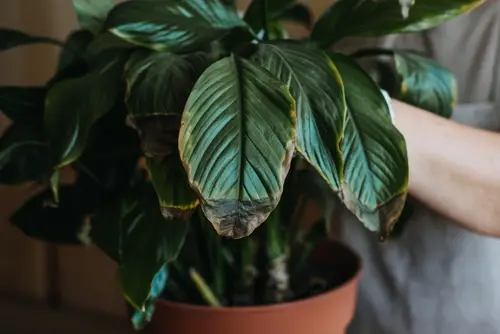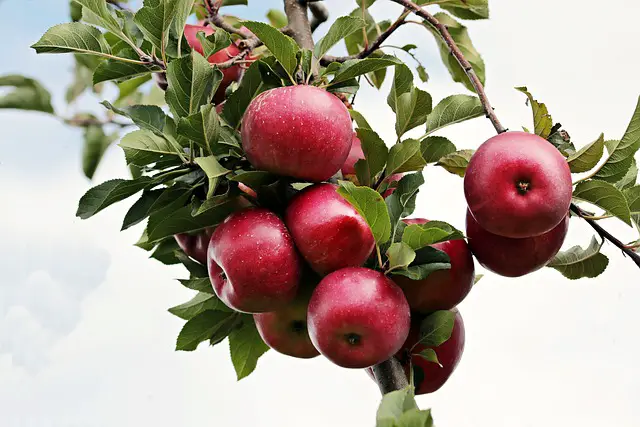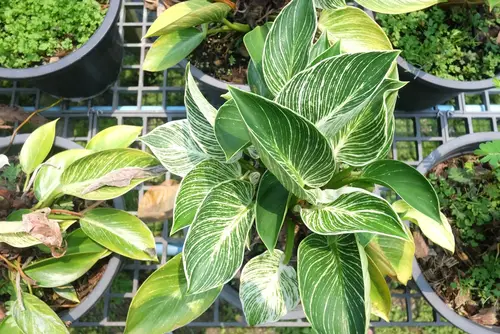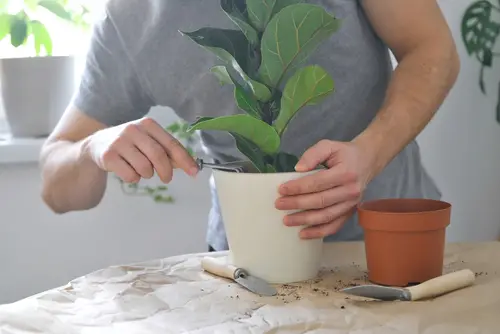White spots on plant leaves can be a sign of a serious problem that could affect the health of your plants. These spots can appear on both indoor and outdoor plants, and they can be caused by a variety of factors. Understanding the causes of white spots on plant leaves is crucial to identifying the specific problem and finding the right treatment.
Common causes of white spots on plant leaves include fungal infections, insect infestations, and nutrient deficiencies. Powdery mildew is a common fungal infection that can cause white spots on leaves, while spider mites and thrips are common insect pests that can also cause white spots.
Nutrient deficiencies, such as a lack of magnesium or calcium, can also cause white spots on plant leaves.Identifying the specific disease or pest that is causing white spots on your plant leaves is key to finding the right treatment.
Different plants are susceptible to different diseases and pests, so it’s important to identify the specific problem before taking action. In this article, we will explore the common causes of white spots on plant leaves, how to identify specific plant diseases, and prevention and treatment methods to help you maintain healthy plant growth.
Key Takeaways
- White spots on plant leaves can be caused by fungal infections, insect infestations, and nutrient deficiencies.
- Identifying the specific disease or pest that is causing white spots is crucial to finding the right treatment.
- Prevention and treatment methods, such as pruning and disposing of infected leaves and maintaining healthy plant growth, can help prevent and treat white spots on plant leaves.
More posts on this category:
Understanding White Spots on Plant Leaves

White spots on plant leaves are a common problem that many gardeners encounter. They can be caused by a variety of factors, including fungal infections, pests, and environmental stressors. Understanding the root cause of white spots on plant leaves is crucial to effectively treating the problem and preventing it from recurring.
One of the most common causes of white spots on plant leaves is powdery mildew. This fungal infection typically appears as white or grayish spots on the leaves, stems, flowers, and fruits of plants.
Powdery mildew is highly contagious and can spread rapidly if left untreated. It thrives in warm, humid conditions and can be particularly problematic in indoor gardens.
White spots on plant leaves can also be caused by pests such as aphids and spider mites. These insects feed on the plant’s sap, which can cause the leaves to develop white or yellow spots. In severe cases, the leaves may become distorted or fall off the plant entirely.
Environmental stressors can also cause white spots on plant leaves. Exposure to extreme temperatures, low humidity, and improper watering can all lead to leaf discoloration and spotting. In some cases, nutrient deficiencies can also cause white spots to appear on the leaves.
To effectively treat white spots on plant leaves, it is important to identify the underlying cause of the problem. This may involve examining the leaves for signs of fungal growth or pest infestation, adjusting environmental conditions, or testing the soil for nutrient deficiencies.
Once the root cause of the problem has been identified, appropriate treatment measures can be taken to eliminate the white spots and prevent them from recurring.
White Spots on My Plant Leaves – 4 Common Problems
White spots on plant leaves can be caused by various factors, including watering issues, high humidity, fungal diseases, and pests. In this section, we will discuss each of these factors in detail.
1. Watering Issues
Overwatering or underwatering your plants can cause white spots on their leaves. When plants receive too much water, their roots can become waterlogged, leading to a lack of oxygen and nutrient uptake.
This can cause the leaves to turn yellow and develop white spots. On the other hand, underwatering can cause the leaves to dry out and develop white spots.
To prevent watering issues, make sure to water your plants according to their specific needs. Check the soil moisture level regularly and adjust your watering schedule accordingly.
2. High Humidity

High humidity can also cause white spots on plant leaves. When the air is too humid, it can create a favorable environment for fungal growth, such as powdery mildew. This can cause the leaves to develop a white, powdery coating.
To prevent high humidity, make sure to provide adequate ventilation for your plants. You can also use a dehumidifier to reduce the humidity level in the air.
3. Fungal Diseases
Fungal diseases, such as powdery mildew, can cause white spots on plant leaves. Powdery mildew is a common fungal infection that affects many plant species. It appears as a white, powdery growth on the surface of the leaves, which can cause yellowing and curling of the affected foliage.
To prevent fungal diseases, make sure to provide proper air circulation for your plants. You can also use fungicides to control the spread of fungal infections.
4. Pests
Pests, such as mealybugs, can also cause white spots on plant leaves. Mealybugs are small, white, fluffy insects that feed on plant sap. They can cause the leaves to turn yellow and develop white spots.
To prevent pest infestations, make sure to inspect your plants regularly for signs of pests. You can also use insecticides to control the spread of pest infestations.
Identifying Specific Plant Diseases
Plant diseases can be caused by various factors, including fungi, bacteria, viruses, and environmental stress. Identifying the specific disease affecting a plant is crucial for effective treatment. Here are some common plant diseases that cause white spots on leaves.
Powdery Mildew
Powdery mildew is a fungal disease that affects a wide range of plants, including vegetables, fruits, and ornamentals. It appears as a white, powdery coating on the surface of leaves, stems, and flowers. The affected leaves may wilt, turn yellow, and eventually die. In severe cases, the entire plant may be affected.
Powdery mildew thrives in warm, humid conditions and can spread rapidly in crowded or poorly ventilated areas. To prevent powdery mildew, avoid over-fertilizing and over-watering plants. If powdery mildew is already present, remove the infected leaves and treat the plant with a fungicide.
Downy Mildew

Downy mildew is another fungal disease that affects many plants, including vegetables, flowers, and trees. It appears as yellow or white spots on the upper surface of leaves and a grayish-white or purple coating on the underside. The affected leaves may wilt, turn yellow or brown, and eventually fall off.
Downy mildew thrives in cool, moist conditions and can spread rapidly in wet weather. To prevent downy mildew, avoid overcrowding plants and provide adequate ventilation. If downy mildew is already present, remove the infected leaves and treat the plant with a fungicide.
Sunburn
Sunburn is not a disease, but it can cause white spots on leaves and other plant parts. Sunburn occurs when plants are exposed to intense sunlight for long periods without adequate protection. The affected leaves may turn white, yellow, or brown and become disfigured.
To prevent sunburn, provide shade or cover plants during the hottest part of the day. Water plants regularly and avoid over-fertilizing or over-pruning. If sunburn is already present, remove the affected leaves and provide shade or cover for the plant.
Impact of White Spots on Different Plants
White spots on plant leaves can be a sign of various issues, and their impact can vary depending on the type of plant. In this section, we will discuss the impact of white spots on different plants, including houseplants, vegetables, fruits, and flowers.
1. Houseplants
Houseplants like begonias, ivy, jade, kalanchoe, and poinsettia are often affected by powdery mildew, which appears as white spots on the leaves.
Powdery mildew can cause yellowing and curling of the affected foliage, and if left untreated, it can weaken the plant and make it more susceptible to other diseases. It is important to address powdery mildew as soon as possible to prevent it from spreading.
2. Vegetables
Vegetables like tomatoes, peppers, squash, cucumbers, and nightshades can also be affected by powdery mildew. The white spots can appear on the leaves, stems, flowers, and even the fruits and vegetables of the plants. P
owdery mildew can reduce the yield and quality of the produce, and it can also make the plants more vulnerable to other pests and diseases.
3. Fruits

Fruit trees like apple, pear, and peach can be affected by powdery mildew, which can cause white spots on the leaves and fruit. The fungus can reduce the yield and quality of the fruit, and it can also make the trees more vulnerable to other pests and diseases.
It is important to address powdery mildew as soon as possible to prevent it from spreading.
4. Flowers
Flowers like roses and begonias can be affected by powdery mildew, which can cause white spots on the leaves and flowers. The fungus can reduce the quality and appearance of the flowers, and it can also make the plants more vulnerable to other pests and diseases. It is important to address powdery mildew as soon as possible to prevent it from spreading.
Prevention and Treatment Methods
1. Proper Watering
One of the primary causes of white spots on plant leaves is overwatering. To prevent this, it is essential to water plants correctly. Always check the soil moisture level before watering.
If the soil is already moist, hold off on watering for a few days. Additionally, make sure to water plants at the base and not on the leaves. Wet leaves can lead to the growth of fungi, which can cause white spots.
2. Maintaining Proper Humidity
Maintaining proper humidity levels can also help prevent the growth of fungi that cause white spots on plant leaves. Most plants prefer a moderate level of humidity, between 40-60%. To maintain proper humidity levels, use a humidifier or a pebble tray. Additionally, avoid placing plants near air conditioning or heating vents, which can dry out the air.
3. Using Fungicides

Fungicides can be an effective treatment for white spots on plant leaves. Daconil Fungicide Ready to Use and Daconil Fungicide Concentrate are two popular options that offer rain-proof, three-way protection to prevent, stop, and control more than 65 plant diseases, including powdery mildew and downy mildew.
Always follow the instructions on the label carefully when using fungicides.
4. Natural Remedies
Several natural remedies can help treat white spots on plant leaves. Neem oil, baking soda, milk, sulfur, and potassium bicarbonate are all effective treatments. To make a milk spray, mix one part milk with two parts water and spray the solution on the affected area.
Copper can also be an effective natural remedy. Mix copper sulfate with water and spray the solution on the affected area. Always test natural remedies on a small area of the plant before applying to the entire plant.
Pruning and Disposing Infected Leaves
When white spots appear on plant leaves, it’s important to take action quickly to prevent further spread. Pruning is one effective method for controlling the spread of white spots on leaves. It is recommended to use plant clippers to remove infected leaves, being careful not to damage the healthy parts of the plant.
When pruning, it is important to cut the infected leaves at the base of the stem, making sure to remove the entire leaf. It is also important to dispose of the infected leaves properly. Infected leaves should be placed in a plastic bag and sealed before being thrown away. This will prevent the spread of the disease to other plants in the area.
In addition to pruning, it is important to inspect the undersides of leaves for signs of white spots. Infected leaves should be removed as soon as possible to prevent the spread of the disease to other parts of the plant.
When using plant clippers, it is important to sanitize them between uses to prevent the spread of disease. Clippers can be sanitized by wiping them down with rubbing alcohol or a solution of one part bleach to nine parts water.
Maintaining Healthy Plant Growth
To maintain healthy plant growth, it’s important to provide the right environment for your plants to thrive. This includes proper fertilization, adequate nutrients, and good air circulation.
Fertilizing your plants is essential for healthy growth. It’s important to use the right type of fertilizer and to apply it at the right time. Different plants require different types of fertilizer, so be sure to research what type of fertilizer is best for your specific plant. Additionally, it’s important to fertilize your plants during the growing season, when they are actively growing and need the most nutrients.
In addition to fertilization, providing adequate nutrients is also important for healthy plant growth. Plants require a variety of nutrients, including nitrogen, phosphorus, and potassium. These nutrients can be found in peat, compost, and other organic materials. Be sure to research what nutrients your specific plant requires and provide them accordingly.
Air circulation is also important for healthy plant growth. Poor air circulation can lead to a variety of issues, including mold and disease. To promote good air circulation, avoid placing plants too close together and ensure that they have enough space to grow tall.
Additional Tips for Plant Care

Taking care of plants can be a rewarding experience, but it can also be challenging, especially when dealing with white spots on the leaves. Here are some additional tips to help keep your plants healthy and thriving:
1. Consider the Garden Environment
The garden environment can have a significant impact on plant health. Consider factors such as wind, temperature, and relative humidity when planning your garden. If you live in a dry climate, you may need to water your plants more frequently to prevent them from drying out.
On the other hand, if you live in a humid climate, you may need to take extra precautions to prevent mildew growth.
2. Use Compost
Compost is an excellent source of nutrients for plants and can help improve soil quality. Using compost can also help reduce the risk of root rot, which can be caused by overwatering. Be sure to use high-quality compost and follow the instructions carefully when applying it to your plants.
3. Choose Mildew-Resistant Varieties
If you live in an area with high humidity or have had issues with mildew in the past, consider choosing mildew-resistant plant varieties. These plants are bred to be more resistant to mildew and other diseases, which can help reduce the risk of white spots on the leaves.
4. Germinate Seeds Indoors
Germinating seeds indoors can help ensure that your plants get off to a healthy start. This can be especially important if you live in an area with a short growing season or if you want to grow plants that require warmer temperatures. Follow the instructions carefully when germinating seeds to ensure that they get the right amount of light, water, and nutrients.
5. Keep Plants Healthy with Proper Nutrition
Proper nutrition is essential for plant health. Be sure to provide your plants with the right amount of water, sunlight, and nutrients to help them grow strong and healthy. Consider using high-quality plant food to help provide your plants with the nutrients they need to thrive.
6. Monitor Plants for Signs of Illness
Regularly monitor your plants for signs of illness or stress. If you notice any white spots on the leaves or other issues, take action immediately to prevent the problem from getting worse. Consider contacting a professional if you are unsure how to treat a sick plant.
7. Place Plants Near a Window
Plants need sunlight to grow, so be sure to place them near a window or in a location where they can get plenty of light. Be sure to rotate your plants regularly to ensure that all parts of the plant get an equal amount of sunlight.
8. Take a Break
Taking a break from caring for your plants can be beneficial for both you and your plants. If you are feeling overwhelmed or stressed, take some time to relax and recharge. Your plants will be there when you are ready to return to caring for them.
Frequently Asked Questions

What causes white spots to appear on plant leaves?
White spots on plant leaves can be caused by a variety of factors such as fungal diseases, insects, and environmental stressors. Powdery mildew is a common fungal disease that causes white spots to appear on the leaves of plants.
Mealybugs and spider mites are insects that can cause white spots on plant leaves. Environmental stressors such as high humidity, poor air circulation, and low light can also cause white spots to appear on plant leaves.
How do you treat white powdery fungus on plants?
To treat white powdery fungus on plants, you can use a variety of methods such as neem oil, baking soda, and fungicides. Neem oil and baking soda are natural remedies that can be sprayed on the affected leaves to kill the fungus.
Fungicides are chemical treatments that can be used to kill the fungus. It is important to follow the instructions on the product label when using fungicides.
How do you get rid of white spots on plants?
To get rid of white spots on plants, you can use a variety of methods such as neem oil, baking soda, and fungicides. Neem oil and baking soda are natural remedies that can be sprayed on the affected leaves to kill the fungus or insects causing the white spots.
Fungicides are chemical treatments that can be used to kill the fungus. It is important to follow the instructions on the product label when using fungicides.
What are the tiny white specks on plants?
Tiny white specks on plants can be caused by a variety of factors such as insect eggs, fungal spores, and mineral deposits. Insect eggs can appear as tiny white specks on plant leaves.
Fungal spores can also appear as tiny white specks on plant leaves. Mineral deposits can appear as white specks on plant leaves when water evaporates, leaving behind minerals.
How to get rid of white fungus on plants?
To get rid of white fungus on plants, you can use a variety of methods such as neem oil, baking soda, and fungicides. Neem oil and baking soda are natural remedies that can be sprayed on the affected leaves to kill the fungus.
Fungicides are chemical treatments that can be used to kill the fungus. It is important to follow the instructions on the product label when using fungicides. In addition, it is important to maintain good plant care practices such as proper watering, good air circulation, and adequate light to prevent the fungus from returning.


